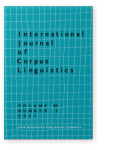Vol. 26:3 (2021) ► pp.336–369
A diachronic corpus-driven study of the expression of possibility in Luganda (Bantu, JE15)
This article employs a 4-million-word diachronic corpus to examine how the expression of possibility has evolved in Luganda since the 1890s to the present, by focusing on the language’s three main potential markers -yînz-, -sóból- and -andi-, and their historical interaction. It is shown that while the auxiliary -yînz- originally covered the whole modal subdomain of possibility, the auxiliary -sóból- has steadily taken over the more objective categories of dynamic possibility. Currently, -yînz- first and foremost conveys deontic and epistemic possibility. It still prevails in these more subjective modal categories even though the prefix -andi-, a conditional marker in origin, has started to express epistemic possibility since the 1940s, and -sóból- deontic possibility since the 1970s. More generally, this article demonstrates the potential of corpus linguistics for the study of diachronic semantics beyond language comparison. This is an important achievement in Bantu linguistics, where written language data tend to be young.
Article outline
- 1.Introduction
- 2.Modality in Bantu languages
- 3.The Luganda corpus and analytical methods
- 4.An account of -yînz-
- 4.1The modal uses of -yînz-
- 4.2The lexical uses of -yînz-
- 4.3Diachronic distributional analysis of -yînz-
- 4.4Is -yînz- an auxiliary or not?
- 5.An account of -sóból-
- 5.1Distributional analysis of -sóból-
- 5.2Diachronic distributional analysis of -sóból-
- 6.An account of -andi-
- 6.1Distributional analysis of -andi-
- 6.2Diachronic distributional analysis of -andi-
- 7.Discussion
- 8.Conclusions
- Notes
-
References
